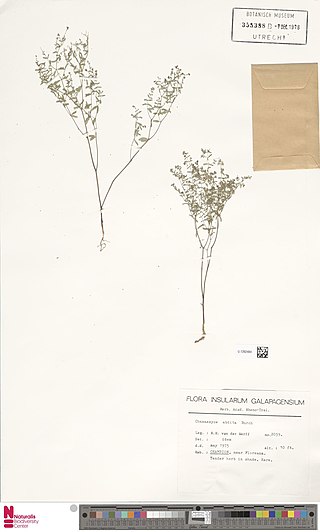
Euphorbia is a very large and diverse genus of flowering plants, commonly called spurge, in the family Euphorbiaceae. "Euphorbia" is sometimes used in ordinary English to collectively refer to all members of Euphorbiaceae, not just to members of the genus.

Euphorbia esula, commonly known as green spurge or leafy spurge, is a species of spurge native to central and southern Europe, and eastward through most of Asia north of the Himalaya to Korea and eastern Siberia.

Euphorbia heterophylla, also known under the common names of (Mexican) fireplant, painted euphorbia, Japanese poinsettia, desert poinsettia, wild poinsettia, fire on the mountain, paintedleaf, painted spurge, milkweed, and kaliko plant, is a plant belonging to the Euphorbiaceae or spurge family.

Euphorbia helioscopia, the sun spurge or madwoman's milk, is a species of flowering plant in the spurge family Euphorbiaceae. It is a herbaceous annual plant, native to most of Europe, northern Africa, and eastward through most of Asia.

Euphorbia myrsinites, the myrtle spurge, blue spurge, or broad-leaved glaucous-spurge, is a succulent species of flowering plant in the spurge family Euphorbiaceae.

Euphorbia resinifera, the resin spurge, is a species of spurge native to Morocco, where it occurs on the slopes of the Atlas Mountains. The dried latex of the plant was used in ancient medicine. It contains resiniferatoxin, an extremely potent capsaicin analog tested as an analgesic since 1997.

Euphorbia maculata, known as spotted spurge, prostrate spurge, milk purslane, or spotted sandmat, is a fast-growing annual plant in the family Euphorbiaceae. While it is native to North America, where it is a common garden and lawn weed in the United States, it has become a common introduced species throughout the world, including Europe, Japan, Korea, Australia, and New Zealand.

Euphorbia corollata is an herbaceous perennial plant in the family Euphorbiaceae that is native to North America. A common name for the species is flowering spurge. It has a milky sap that can cause skin and eye irritation in some people. It grows up to 1 m (3 ft) tall, with smooth stems and light green leaves arranged alternately or in whorls. Leaves are about 10 mm wide and 75 mm (3 in) long. Each stem terminates in a panicle 20 to 25 mm across. Flowers are about 6 mm across and consist of one pistillate and several staminate flowers surrounded by five white bracts - not petals but formed from the involucre at the base of the flowers. Flowering spurge blooms from June to September.

Euphorbia misera is a semi-succulent shrub in the genus Euphorbia commonly known as the cliff spurge or coast spurge. A drought-deciduous shrub, it is typically found as a gnarled, straggly plant occupying seashore bluffs, hills and deserts. Like other members of its genus, it has a milky sap, which can be found exuding out of the light gray bark when damaged. The alternately-arranged leaves are round and folded in the middle, with small hairs on them. The "flowers" can be found blooming year-round, and are colored maroon or yellow in the center with 5 white to light-yellow petal-like appendages attached outside. This species is native to the Baja California peninsula and Sonora in Mexico, and the coast of southern California in the United States, where it is a rare species. It is threatened in some localities by the development of its coastal habitat, which tends to be prime locations for high-end residential and commercial developments.

Euphorbiaceae, the spurge family, is a large family of flowering plants. In English, they are also commonly called euphorbias, which is also the name of a genus in the family. Most spurges, such as Euphorbia paralias, are herbs, but some, especially in the tropics, are shrubs or trees, such as Hevea brasiliensis. Some, such as Euphorbia canariensis, are succulent and resemble cacti because of convergent evolution. This family has a cosmopolitan global distribution. The greatest diversity of species is in the tropics, however, the Euphorbiaceae also have many species in nontropical areas of all continents except Antarctica.

Euphorbia virgata, commonly known as leafy spurge, wolf's milk leafy spurge, or wolf's milk is a species of spurge native to Europe and Asia, and introduced in North America, where it is an invasive species.

Euphorbia mesembryanthemifolia, commonly called seaside spurge, is a species of flowering plant in the spurge family (Euphorbiaceae). It is native to the Western Hemisphere, where it is found in coastal areas from Florida in the United States south to Colombia and Venezuela, as well as in Bermuda and the Caribbean. Its natural habitat is on beaches and rocky shores.

Euphorbia abdita is a member of the spurge family, Euphorbiaceae. It is endemic to the Galápagos Islands.

Euphorbia ipecacuanhae, known by the common names of Carolina ipecac, American ipecac, and ipecac spurge, is a member of the spurge family, Euphorbiaceae. It is a perennial herb, native to the seaboard of the eastern United States, from South Carolina to Long Island.

Euphorbia curtisii, known by the common names of Curtis' spurge and sandhills spurge, is a member of the spurge family, Euphorbiaceae. It is a perennial herb, native to the southeastern United States, from the southern coast of Alabama to central North Carolina.

Euphorbia hyssopifolia, known by the common name of hyssopleaf sandmat in English and hierba de pollo in Spanish, is a member of the spurge family, Euphorbiaceae. It is an annual herb, native to Central and South America and the Southeastern United States. It has also been introduced to west Tropical Africa, India, and Australia.

Euphorbia exserta, known by the common name of coastal sand spurge, is a member of the spurge family, Euphorbiaceae. It is a perennial herb, native to the southeastern United States, from central Florida to North Carolina.

Euphorbia humistrata, known by the common names of spreading sandmat or spreading broomspurge, is a member of the spurge family, Euphorbiaceae. It is an annual herb, native to the southern and midwestern United States.


















